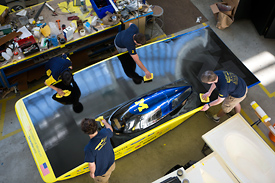More online
The lopsided solar car named Generation, unveiled last week, might be the oddest-looking vehicle the top-ranked U-M team has ever built. But the bold shape is a calculated effort to design the most efficient car possible, given major changes in World Solar Challenge race rules.
The World Solar Challenge is an 1,800-mile, weeklong endurance contest across Australia that takes place every other fall. The U-M team has come in third place five times, most recently in 2011. The reigning national champions are hoping that Generation can carry them to their first world race victory this October.
“We spent a lot of time refining the design and we’re feeling really good about it,” said Eric Hausman, team project manager and a rising senior in industrial and operations engineering.
The most significant rule change for 2013 is that cars must have four wheels instead of three. That, Hausman says, is the biggest shift since 2007, when the driver moved from lying down to being seated. Both new requirements called for teams to essentially start from scratch and outline new vehicle shapes.
“So in ’07, you had to figure out where to put the driver in the air foil,” Hausman said. “This year, it’s similar. You have to figure out how to arrange the wheels and the driver in the new optimal position, and we think we’ve found that basic geometry.”
The component the team had the most leeway with wasn’t the wheels, but rather the driver’s seat — nicknamed the “butt bucket” by the team because that’s essentially what it is. In the old three-wheeled cars, the butt bucket was situated right behind the front wheel — encased in the same fairing, actually.
Under the new rules, the wheels can’t be right next to each other, so if the team were to arrange them like wheels in a regular car, the bucket would hang down below the lower surface, reducing the car’s efficiency. So the team didn’t put it there.
“We have the driver and two wheels all in one giant fairing on the left side of the car, and on the right side we have two small fairings — one for each wheel,” Hausman said. “Aerodynamically, it’s about creating as few bumps on the surface as possible. The design also reduces shading of the solar cells by placing the canopy to the side.”

Members of the Solar Car Team polish the surface and newly acquired canopy of the 2013 U-M solar car, Generation, in the Wilson Center. Photo by Joseph Xu, Michigan Engineering Communications & Marketing.
From the front, Generation is reminiscent of a motorcycle with a sidecar, but it’s not as lopsided as it looks, the students say. The team put most of the heavy equipment on what would be the passenger’s side to keep Generation’s center of gravity in its center — where it needs to be to keep the car stable.
“Having four wheels will change a lot of things about the way we race this car,” said Matt Goldstein, a rising senior in computer science and engineering who heads the team’s strategy division. “This is a new concept to us and a different design, so we will have to adjust our strategy appropriately. The new regulations will definitely stir the pot, and I am excited to make our best shot at a championship.”
The team has described its cars as “ultimate electric vehicles,” as they run off a battery charged by sunlight. While solar cars aren’t likely to be viable in the near future, there are other more immediate applications for the technologies the team develops, working in close collaboration with industry.
“We are very proud of this car,” said crew chief Bryan Mazor, a rising senior in physics who leads the team’s engineering division. “It is a very efficient, very aerodynamic design. We were also able build faster than ever through the support of our sponsors. Now we’ll be able to test every facet of this car, in preparation for World Solar Challenge.”
Major sponsors this year include General Motors, Ford, IMRA, the College of Engineering, Qatar Airways and Siemens.
The World Solar Challenge is Oct. 6-13 from Darwin to Adelaide, Australia.

